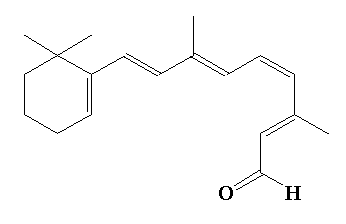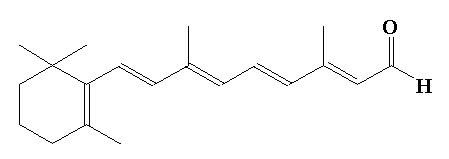
How are cis and trans isomers used for night vision?
Answer
542.1k+ views
Hint: The cis and trans isomers are observed in compound containing double bond. In cis-isomer the two similar group are present on same side of the double bond. In trans-isomer the two similar groups are present on the opposite side of the double bond. The retinal contains two types of isomer 11-cis-retinal and all-trans-retinal.
Complete step by step answer:Most of the mammals have the property of night vision. Retinal is the molecule which helps in vision. The two isomers are characteristic which are responsible for converting the energy in light photons into electrical impulses in the retina. Two isomers involved are 11-cis-retinal and all-trans-retinal. The number 11 in 11-cis-retinal represents the double bond present on the 11th carbon from the end with a ring.
The structure of 11-cis-retinal is shown below.

The structure of all-trans-retinal is shown below.

There are three steps involved in producing the visual signal.
(1) Isomerization of retinal:
When the photon light hits the rod or cone cell, the pi electrons absorb light and get excited to a higher energy level. As a result the carbon-carbon double bond present between C11 and C12 breaks down and by rotating form all-trans isomers.
(2) Protein conformational change:
The 11-cis-retinal is bound to a protein. When the 11-cis-retinal transform to all-trans isomer, the new structure is no longer able to fit in the protein. Due to this, the all-trans-retinal adopts an energetically unfavourable conformation and as a result it is expelled from the protein.
(3) Generation of nerve impulses:
During the expulsion of all-trans-retinal, intermediates are formed out of which one of the intermediate activates the enzyme that activates the series of biochemical reactions which produce nerve impulse to the brain.
Note:
For seeing the colour, there are mainly three type of visual receptors which are sensitive to red, green and blue light but 11-cis retinal is common in all the molecule.
Complete step by step answer:Most of the mammals have the property of night vision. Retinal is the molecule which helps in vision. The two isomers are characteristic which are responsible for converting the energy in light photons into electrical impulses in the retina. Two isomers involved are 11-cis-retinal and all-trans-retinal. The number 11 in 11-cis-retinal represents the double bond present on the 11th carbon from the end with a ring.
The structure of 11-cis-retinal is shown below.

The structure of all-trans-retinal is shown below.

There are three steps involved in producing the visual signal.
(1) Isomerization of retinal:
When the photon light hits the rod or cone cell, the pi electrons absorb light and get excited to a higher energy level. As a result the carbon-carbon double bond present between C11 and C12 breaks down and by rotating form all-trans isomers.
(2) Protein conformational change:
The 11-cis-retinal is bound to a protein. When the 11-cis-retinal transform to all-trans isomer, the new structure is no longer able to fit in the protein. Due to this, the all-trans-retinal adopts an energetically unfavourable conformation and as a result it is expelled from the protein.
(3) Generation of nerve impulses:
During the expulsion of all-trans-retinal, intermediates are formed out of which one of the intermediate activates the enzyme that activates the series of biochemical reactions which produce nerve impulse to the brain.
Note:
For seeing the colour, there are mainly three type of visual receptors which are sensitive to red, green and blue light but 11-cis retinal is common in all the molecule.
Recently Updated Pages
A man running at a speed 5 ms is viewed in the side class 12 physics CBSE

State and explain Hardy Weinbergs Principle class 12 biology CBSE

Which of the following statements is wrong a Amnion class 12 biology CBSE

Two Planoconcave lenses 1 and 2 of glass of refractive class 12 physics CBSE

The compound 2 methyl 2 butene on reaction with NaIO4 class 12 chemistry CBSE

Bacterial cell wall is made up of A Cellulose B Hemicellulose class 12 biology CBSE

Trending doubts
What are the major means of transport Explain each class 12 social science CBSE

Which are the Top 10 Largest Countries of the World?

Draw a labelled sketch of the human eye class 12 physics CBSE

Explain sex determination in humans with line diag class 12 biology CBSE

The pH of the pancreatic juice is A 64 B 86 C 120 D class 12 biology CBSE

Give 10 examples of unisexual and bisexual flowers




